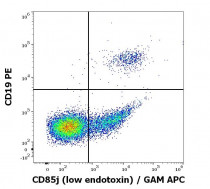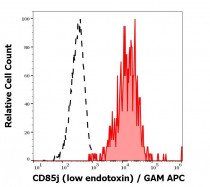ARG42246
anti-CD85j / LIR1 antibody [GHI/75] (low endotoxin)
anti-CD85j / LIR1 antibody [GHI/75] (low endotoxin) for Flow cytometry,Functional study,Immunoprecipitation,Western blot and Human
Overview
| Product Description | Azide free and low endotoxin Mouse Monoclonal antibody [GHI/75] recognizes CD85j / LIR1 |
|---|---|
| Tested Reactivity | Hu |
| Tested Application | FACS, FuncSt, IP, WB |
| Specificity | The mouse monoclonal antibody GHI/75 recognizes an extracellular epitope of CD85j / ILT2, an 110-120 kDa membrane glycoprotein expressed strongly on plasma cells, moderately on circulating B cells, and weakly on monocytes. It is also expressed on T cell and NK cell subsets (variable, individual). |
| Host | Mouse |
| Clonality | Monoclonal |
| Clone | GHI/75 |
| Isotype | IgG2b, kappa |
| Target Name | CD85j / LIR1 |
| Antigen Species | Human |
| Immunogen | Hairy cell leukaemia cells. |
| Conjugation | Un-conjugated |
| Alternate Names | LIR-1; Leukocyte immunoglobulin-like receptor 1; ILT2; CD85 antigen-like family member J; Immunoglobulin-like transcript 2; LIR1; ILT-2; Leukocyte immunoglobulin-like receptor subfamily B member 1; Monocyte/macrophage immunoglobulin-like receptor 7; CD antigen CD85j; CD85J; MIR7; MIR-7 |
Application Instructions
| Application Suggestion |
|
||||||||||
|---|---|---|---|---|---|---|---|---|---|---|---|
| Application Note | * The dilutions indicate recommended starting dilutions and the optimal dilutions or concentrations should be determined by the scientist. |
Properties
| Form | Liquid |
|---|---|
| Purification | Purification with Protein A. |
| Purification Note | 0.2 µm filter sterilized. Endotoxin level is <0.01 EU/µg of the protein. |
| Buffer | PBS |
| Concentration | 1 mg/ml |
| Storage Instruction | For continuous use, store undiluted antibody at 2-8°C for up to a week. For long-term storage, aliquot and store at -20°C or below. Storage in frost free freezers is not recommended. Avoid repeated freeze/thaw cycles. Suggest spin the vial prior to opening. The antibody solution should be gently mixed before use. |
| Note | For laboratory research only, not for drug, diagnostic or other use. |
Bioinformation
| Database Links |
Swiss-port # Q8NHL6 Human Leukocyte immunoglobulin-like receptor subfamily B member 1 |
|---|---|
| Gene Symbol | LILRB1 |
| Gene Full Name | leukocyte immunoglobulin-like receptor, subfamily B (with TM and ITIM domains), member 1 |
| Background | This gene is a member of the leukocyte immunoglobulin-like receptor (LIR) family, which is found in a gene cluster at chromosomal region 19q13.4. The encoded protein belongs to the subfamily B class of LIR receptors which contain two or four extracellular immunoglobulin domains, a transmembrane domain, and two to four cytoplasmic immunoreceptor tyrosine-based inhibitory motifs (ITIMs). The receptor is expressed on immune cells where it binds to MHC class I molecules on antigen-presenting cells and transduces a negative signal that inhibits stimulation of an immune response. It is thought to control inflammatory responses and cytotoxicity to help focus the immune response and limit autoreactivity. Multiple transcript variants encoding different isoforms have been found for this gene. [provided by RefSeq, Jul 2008] |
| Function | Receptor for class I MHC antigens. Recognizes a broad spectrum of HLA-A, HLA-B, HLA-C, HLA-G and HLA-F alleles (PubMed:16455647, PubMed:28636952). Receptor for H301/UL18, a human cytomegalovirus class I MHC homolog. Ligand binding results in inhibitory signals and down-regulation of the immune response. Engagement of LILRB1 present on natural killer cells or T-cells by class I MHC molecules protects the target cells from lysis. Interaction with HLA-B or HLA-E leads to inhibition of FCER1A signaling and serotonin release. Inhibits FCGR1A-mediated phosphorylation of cellular proteins and mobilization of intracellular calcium ions (PubMed:11907092, PubMed:9285411, PubMed:9842885). Recognizes HLA-G in complex with B2M/beta-2 microglobulin and a nonamer self-peptide (PubMed:16455647). Upon interaction with peptide-bound HLA-G-B2M complex, triggers secretion of growth-promoting factors by decidual NK cells (PubMed:29262349, PubMed:19304799). Reprograms B cells toward an immune suppressive phenotype (PubMed:24453251). [UniProt] |
| Cellular Localization | Cell membrane; Single-pass type I membrane protein. Isoform 5: Secreted. [UniProt] |
| Calculated MW | 71 kDa |
| PTM | Phosphorylated on tyrosine residues. Dephosphorylated by PTPN6. [UniProt] |
Images (3) Click the Picture to Zoom In
-
ARG42246 anti-CD85j / LIR1 antibody [GHI/75] (low endotoxin) FACS image
Flow Cytometry: Human peripheral blood stained with ARG42246 anti-CD85j / LIR1 antibody [GHI/75] (low endotoxin) at 1 µg/ml dilution, followed by APC-conjugated Goat anti-Mouse antibody.
-
ARG42246 anti-CD85j / LIR1 antibody [GHI/75] (low endotoxin) FACS image
Flow Cytometry: Human lymphocytes stained with ARG42246 anti-CD85j / LIR1 antibody [GHI/75] (low endotoxin) at 1 µg/ml dilution, followed by APC-conjugated Goat anti-Mouse antibody. Samples were co-stained with ARG53783 anti-CD19 antibody [LT19] (PE) at 20 µl / 100 µl of peripheral whole blood.
-
ARG42246 anti-CD85j / LIR1 antibody [GHI/75] (low endotoxin) FACS image
Flow Cytometry: Separation of Human CD85j positive B cells (red-filled) from neutrophil granulocytes (black-dashed). Human peripheral whole blood stained with ARG42246 anti-CD85j / LIR1 antibody [GHI/75] (low endotoxin) at 1 µg/ml dilution, followed by APC-conjugated Goat anti-Mouse antibody.








